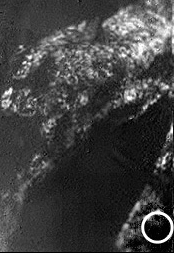
Its subsequent descent through the cold atmosphere is controlled by a sequence of 3 parachutes, and a complex ballet of instrument activity begins. A look back at the 1st hours following Huygens’ landing, from reception of the 1st signal to the initial hypotheses of the science team, which went through the full gamut of emotions from extreme tension to uncontained joy…
A view of Huygens’ probable landing site based on initial, best-guess estimates. The descent lasted 2 hours and 32 minutes. The signal from the probe was lost 72 minutes after landing, as Cassini passed over Titan’s horizon. Huygens is thought to have continued functioning for more than 5 hours, but only analysis of data picked up by European radiotelescopes will tell for sure.
Anxious minutes

| Fact file |
| Early status report Just 20 W, fainter than a domestic light bulb: that’s how weak the signal beamed by Huygens to Cassini was. Some 18 radiotelescopes on Earth pointed their antennas toward Saturn with a slim chance of picking up this signal. Indeed, scientists did not envisage using radiotelescopes until 1 year before Huygens’ arrival, when they realized it would be theoretically possible to detect the probe, thus providing a status check a full 3 hours before Cassini started sending data back to Earth. A plus for science teams, even though a failure to detect a signal—while it would certainly have upped the tension in the control centre—would not mean the mission itself had failed. |
Preliminary analyses

Another hypothesis still to be confirmed is the presence of methane rain. Readings from the HASI** instrument, which recorded a ground temperature of –180°C and pressure of 1.5 bars, confirm current thermodynamic models and would appear to support this conclusion. The GCMS** instrument also sensed a burst of methane gas boiled off from the surface as heat generated by the probe warmed the soil beneath it. This suggests Titan’s subsurface is soaked in liquid methane.
* ESOC: European Space Operations Centre
** HASI: Huygens Atmospheric Structure Instrument
GCMS: Gas Chromatograph & Mass Spectrometer